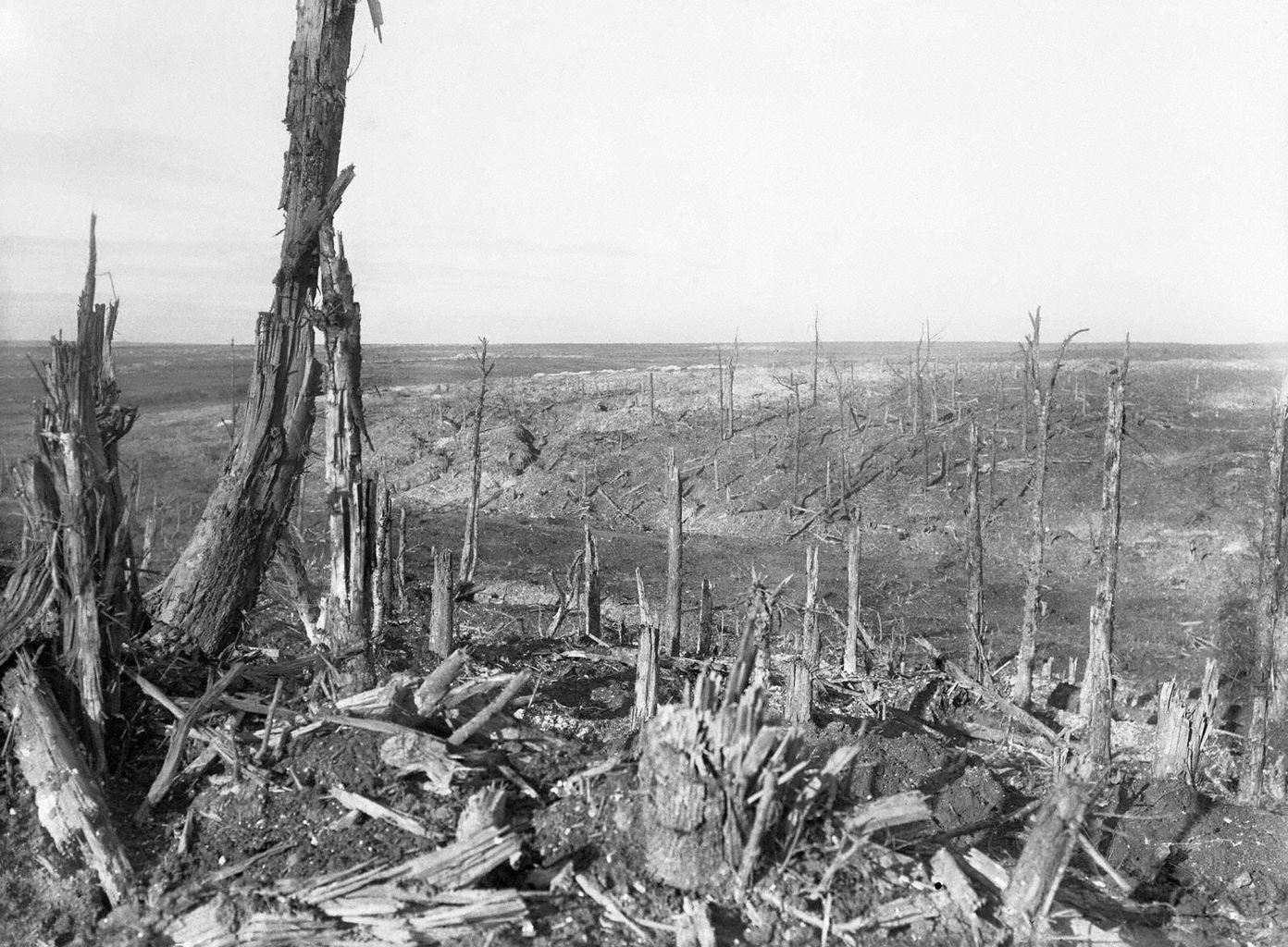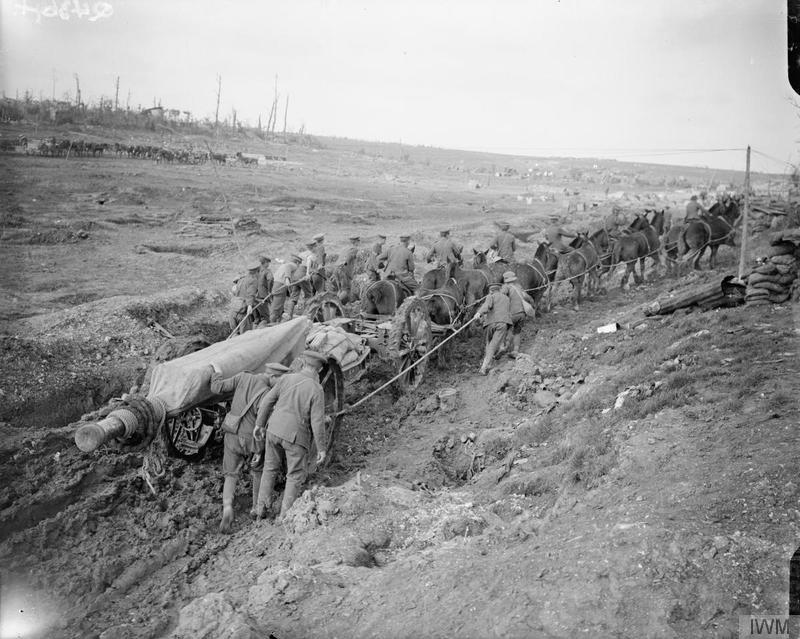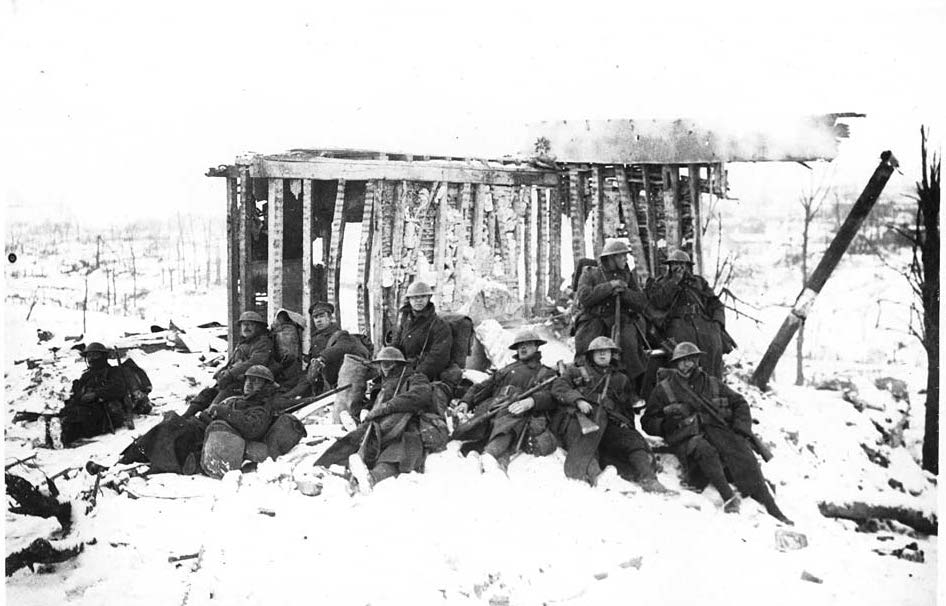Battle of the Somme Autumn 1916

Battlefield of Beaumont Hamel, image Q1523 courtesy of the Imperial War Museum, London
(photograph by official photographer Lieutenant Ernest Brooks)
Several conflicts took place at the Somme in September 1916, including the battles of Guillemont, Ginchy, Flers-Courclete, Morval and Thiepval.
September 3rd 1916, Beaumont Hamel. Death of Sergeant 28393 William Barratt, 17th Bn. Sherwood Foresters, 117th Brigade, 39th Division, V Corps. He was formerly an attendant at Notts. County Asylum (Saxondale) and was killed in action, age 28, during an attack between Hamel and Beaumont Hamel. The 39th Division moved on to the attack on Thiepval Ridge at the end of September.
From Sherwood Foresters War Diaries (held at the Worcestershire and Sherwood Foresters Regimental Museum, Nottingham)
3rd Sept 1916, 5.10 a.m. Battalion move to attack under Artillery Barrage at 6.0 a.m. Message received from Major. G. Stollard Comdg. A Coy. that we have occupied First line of German trenches.
At 6.10 a.m. Message received from Captain H.V. Walters that the enemy’s 2nd Line is strongly held with Machine guns and that our Casualties are very heavy and reinforcements are urgently needed.
At 7.15 a.m. 2 Companies of K.R.R. Corps. move up to reinforce. The Action is against us, the enemy being very strong in Artillery and Machine guns, and at 2.00 p.m. orders are despatched for all to withdraw to our trenches.
At 7.30 p.m. the Battalion remaining withdrew to a Hill-side at Mailley, Maillet Wood, for the night. Our casualties are very heavy. 59 killed, 221 missing in action, 156 wounded.
Another account of the conflict is given by Andrew Rawson (2016, p. 119) in Ancestor’s Footsteps. The Somme 1916 (Barnsley: Pen and Sword)
The width of no man’s land had been underestimated and the men were still crossing it when the barrage moved forward at 5.10 a.m. It also landed behind one salient, allowing German machine gun teams to stop the 17th Sherwoods.
September 16th 1916, Thiepval Ridge. Death of Private 34774 Walter Dawson, 9th Bn., Sherwood Foresters, 33rd Brigade, 11th (Northern) Division, II Corps. He was an apprentice butcher from Radcliffe. Killed in action, age 25, during push on Thiepval Ridge, prior to the main battle which began on September 26th. An account of what happened on that day is given in the Nottinghamshire Great War Roll of Honour:
On 16th September the battalion was in support of the 6th Lincolnshire Regiment who attacked and took Constance trench. During this action ‘D’ company moved up in close support of 6th Lincolns and two other ranks died, one being Walter. He is commemorated on the Thiepval Memorial, Somme (source: Nottinghamshire Great War Roll of Honour).
Andrew Rawson (2016, p. 103) shows the 11th (Northern) Division were at Skyline Ridge, positioned between Authuille and Ovillers- la- Boiselle:
At 6.30pm on 14 September, the 6th Green Howards, 9th West Yorkshires and the 8th Dukes advanced from Hindenburg Trench. The artillery missed Turk Trench and the Green Howards suffered heavy casualties but the West Yorkshires entered the Wonder Work. On the 16th September the 9th Sherwoods and 6th Lincolns’ bombers cleared Constance Trench.
Large-scale offensive operations were planned for the autumn on the Somme after the September occupation of most of the Thiepval Ridge line. The Battle of the Transloy Ridges was part of the overall strategy, followed by the battle of the Ancre. During this period, terrible weather grounded aircraft and increased the difficulties of transporting supplies to the front line as the British slowly advanced towards higher ground against numerous counter attacks. The Battle of Transloy was the last involvement of the Fourth Army on the Somme.
How Radcliffe servicemen died
Radcliffe Servicemen and British Army
1914 Retreat from Mons
1914 Battle of the Marne, 1st Battle of Ypres
1915 Battle of Neuve Chapelle, Aubers Ridge
1915 Gallipoli
1915 2nd Battle of Ypres and other conflicts
1916 Conflicts prior to the Somme
1916 Battle of the Somme July
1916 Battle of the Somme August
1916 Battle of the Somme Autumn
1917 Battle of Arras
1917 3rd Battle of Ypres
1917 3rd Battle of Ypres (Passchendaele)
1918 German Spring Offensive
1918 3rd Battle of the Aisne
1918 HMS Leasowe Castle torpedoed
1918 Last 100 Days, 5th Battle of Ypres
1918 Final Days
1918 The Armistice

Battle of Transloy Ridges. A team of twelve horses and men from the Royal Field Artillery transport a 60 pounder gun near Bazentin le Petit, Somme area.October 1916. Courtesy of Imperial War Museum, London.
Photograph by official photographer Lieutenant John Warwick Brooke.
Battle of Le Transloy
1st – 18th October 1916
The attack on October 1st was conducted by III Corps and the New Zealand Division of XV Corps. The Fourth Army’s objectives required taking Eaucourt L’Abbaye and an advance on III Corps’ entire front was launched, after a seven-hour bombardment. The New Zealand Division was at Goose Alley that day, west of Gueudecourt and south- east of Eaucourt L’Abbaye. The 2nd Brigade’s Otago and Canterbury battalions captured positions near Eaucourt L’Abbaye but met fierce German resistance. According to Andrew Rawson (2016):
At 3.15 on 1 October, thirty Liven Projectors around Goose Alley fired burning oil over the Gird Trenches. Then the Otago Battalion advanced past the Circus and stopped on the Le Barque Road, north – east of Eaucourt L’Abbaye. The Canterbury Battalion cleared the east end of Circus Trench and the German End of the Gird Trenches. (Rawson. A. (2016, p. 183) Ancestor’s Footsteps, The Somme, 1916 (Barnsley: Pen and Sword)
October 1st, Le Transloy. Wounding of Sidney Bell, 10th Canterbury Reinforcements, 1 Brigade, New Zealand Division. He was from Radcliffe on Trent, fought in the Boer War and emigrated to New Zealand in 1911. He was discharged from the army following his injuries and died of heart problems at Killinchy, New Zealand, in January 1918 at the age of forty six.
The objectives were not secured until October 3rd. Between September 15th and October 4th, when it withdrew from the front lines, the New Zealand Division suffered 7,000 casualties, 1,500 of them fatal.
The follow-up attack was delayed by terrible weather until 7th October. The advance resulted in heavy British casualties and little success. Continuous rain hampered the removal of casualties and further forward moves. The 2nd Battalion of the Sherwood Foresters was present, fighting with the sixth division.
October 10th 1916, Bernafay Wood. Death of Private 91333 Charles Tytherley, 2nd Bn. Sherwood Foresters, 71st Brigade, 6th Division, XIV Corps, a regular soldier, who was billeted in Radcliffe before leaving for the Front. He was killed near Bernafay Wood, 10 km east of Albert, age 28.
From Sherwood Foresters War Diaries (held at the Worcestershire and Sherwood Foresters Regimental Museum, Nottingham)
On October 10th 40 N.C.Os and men were on fatigue at Brigade Head Qrs. during the day. 6 Officers and 290 other ranks went up and dug assembly trenches behind the Front line trench during the night and 1 Officer and 100 other ranks carried rations etc. for the 9th Suffolk Regt. who were holding the front line trenches. Digging parties had rather a warm time from enemy machine gun fire and a few shells.
The failure to secure objectives led to a renewed major assault on the afternoon of 12th October when infantry on the Fourth Army’s right struggled to reach German trench lines in front of Le Transloy, while formations on the left pushed on towards the Butte de Warlencourt. Despite slight gains, the operation was not successful.
Orders for a fresh attack, issued on 13 October, ignored the desperate conditions: ‘the weather conditions were appalling, pitch black, pouring with rain and freezing cold ‘ (from the War Diaries of the East Lancashire Regiment). The subsequent early morning assault on 18th October when it was still dark saw tremendous attempts to advance but little success. The East Lancashire Regiment, fighting with the 4th Division, suffered heavy losses.
October 18th, Le Transloy. Death of Private 29302 Thomas William James, 1st Bn East Lancashire Regiment, 11th Brigade, 4th Division, XIV Corps. He was a former farm labourer from Holme Pierrepont, Notts., age 24. The following extract from the regimental war diary was written by Lt. Colonel Charles James Burke DSO who was in command. It describes the circumstances in which Thomas James lost his life.
Orders received to take over line that night and that attack would be at 3.40am on 18th i.e. by night instead of by day. This was most unfortunate, as only Company Commanders had been up the line, and the men would have no opportunity of seeing the ground they would have to attack over. The Bn moved off by platoons at 5.30pm to take over the line from the 2nd Seaforths, and occupy Assembly trenches for the attack on the 18th. The night was very dark, and pouring with rain. The relief was a very difficult matter; the roads were terribly blocked by transport and in a frightful condition from the rain. Cross country tracks were impassable. The relief was not completed till about 3am on 18th. 2 platoons whose guides had lost their way did not get into position with their Coys, and only joined up later in the day after the attack …
I think that no rifles of the men who went forward could have been in working order 10 minutes after they left our lines. The ground was terribly torn up by shell fire and as slippery as ice. The men kept on slipping and falling into the holes in the dark. The few who returned were one mass of mud from head to foot and completely exhausted.
Battle of the Ancre
November 13th – 18th 1916
The weather deteriorated further in November with the Battle of the Ancre fought in fog and snow from the same front lines of the failed attack on July 1st. Fifth army was present. The main objective was the elimination of the German salient between the Albert to Bapaume Road and Serre with Beaumont Hamel at its head. Beaumont Hamel was finally captured in the battle.
November 13th 1916, Beaumont Hamel. Death of Lt John Richards, 1st Royal Marine Light Infantry, 63rd (Royal Naval) Division, VIII Corps. Killed in action, age 29. He was a solicitor, born in Radcliffe and son of the deputy town clerk of Nottingham. The battalion moved from HQ at Engelbelmer, November 8th to the trenches. The 63rd division reached the outskirts of Beaucourt on the 13th and secured it on the 14th – a notable achievement. Ray Westlake describes the positions of the Royal Naval Division in the build up to and during the conflict as follows:
63rd Royal Naval Division to Engelbelmer (25/10). Front line (28/10), Engelbelmer (30/10), Varennes (31/10), Puchevillers (5/11), front line (7/11), Engelbelmer (8/11), Varennes (9/11), front line (10/11). Attack on Beaucourt (13/11) – on left of 188th Brigade’s assault – heavy casualties (including all 4 company commanders) soon after leaving start positions – small parties only fighting through to German third line. Relieved and via Hédauville to Puchevillers (15/11). War Diary notes ‘advanced 490 strong, returned 138 – casualties 352.’(Excerpt From: Westlake, Ray. “Tracing British Battalions on The Somme.” Pen & Sword, 2011. iBooks.)
Andrew Rawson (2016, p. 209) is more specific about the fate of the Royal Marines that day:
The 1st and 2nd Royal Marines and the Howe and Anson battalions were pinned down in no man’s land and only a few reached Station Road. The Hawke and Nelson battalions took heavy casualties but the Hood and the Drake battalions captured the front trenches. Source: Rawson, Andrew (2016) Ancestor’s Footsteps. The Somme 1916 (Barnsley: Pen and Sword).

Infantry resting in the snow. Attributed to official British photographer Llieutenant John Warwick Brooke.
Image no. (540) D.804 courtesy of www.digital.nls.uk (National library of Scotland)
The Battle of the Somme ended on 18th November with enormous cost and only a few miles gained. Over the months of the battle, the Allies had learnt tactics and strategies which assisted them as the war continued.
